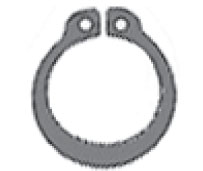 When most people think of fasteners, they envision nuts and screws. While threaded fasteners such as these are common, there are other fasteners that don’t feature any threading. Retaining rings fall under the latter category. They are used in fastening applications, but retaining rings don’t feature threading, nor do they feature the same cylindrical shape as bolts and screws.
When most people think of fasteners, they envision nuts and screws. While threaded fasteners such as these are common, there are other fasteners that don’t feature any threading. Retaining rings fall under the latter category. They are used in fastening applications, but retaining rings don’t feature threading, nor do they feature the same cylindrical shape as bolts and screws.
Overview of Retaining Rings
Also known as snap rings or snap clips, retaining rings are circular-shaped fasteners that are designed for use with shafts or bores. They essentially create a “shoulder” on the shaft or bore that holds the respective part in place.
There are different styles of retaining rings, including tapered and untapered. Tapered retaining rings live up to their namesake by featuring a tapered design. In other words, they become narrower towards the opening. Untapered retaining rings don’t feature a tapered design. Instead, they retain their thickness throughout.
There are also spiral retaining rings. Spiral retaining rings are similar to untapered retaining rings: both styles feature an untapered design with the same thickness. The difference is that spiral retaining rings consist of a closed circle, whereas untapered retaining rings — as well as tapered retaining rings — feature an open circle. They have a small open section cut out.
How Retaining Rings Work
You might be wondering how retaining rings work. While available in different styles, all retaining rings work in the same way. You can place a retaining ring on a shaft or inside of a bore.
Retaining rings can be placed around shafts. Assuming a shaft has a precut groove, you can place a retaining ring in this groove so that it holds the assembly in place.
Retaining rings can also be placed in bores. Bores are openings. As long as a retaining ring is an appropriate size, it will fit inside of the groove of a bore while subsequently holding the assembly in place.
Retaining rings are strong. They are typically made of metal alloys like stainless steel. And whether it’s a tapered, untapered or spiral retaining ring, it will feature a circular shape that accommodates shafts and bores.
In Conclusion
Some fasteners are threaded, whereas others are unthreaded. A retaining ring is a type of unthreaded fastener that’s used to hold shaft and bore assemblies in place. They are available in different styles, but all retaining rings work by holding the assemblies with which they are used in place.



